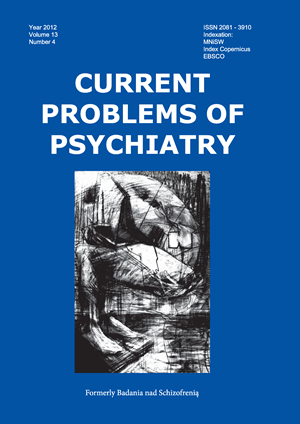Analysis of psychological functioning of patients after their suicide attempts
DOI:
https://doi.org/10.12923/j.2081-3910/13.4/a.03Keywords:
suicide, psychological functioning, suicidal behaviourAbstract
Suicide is a serious psychiatric problem. A deliberate act of taking their own lives by patients is a difficult and dramatic move. There has been ongoing discussion about causes of this phenomenon and they still have not been established unequivocally. There are numerous theories on the etiology of suicidal behaviors including a sociological theory, cognitive-behavioral theory and neurobiological theories.
Material and methods. The research is based on the survey of the control group that consisted of 76 persons including 48 of those who had already attempted suicide. Among the group were also Lodz Babinski Hospital patients who attempted suicide recently or in the more distant past. Each patient did psychological CISS and IPSA-II tests.
Results. A statistical analysis shows that patients attempting suicide differ in psychological traits from the rest of the control group. They have greater aggressive tendencies and difficulties in controlling emotions. They also tend to be less trusting.
Conclusions. It is possible to attempt to prevent suicide. A psychological profile of those who attempt suicide could lead to a better understanding of mechanisms that underlie self-destructive actions and help identify a group of persons with a significantly greater suicidal behavior risk and apply preventive measures to those persons.
References
1. Stengel E., Cook N.G. Contrasting suicide rates in industrial communities. J. Ment Sci. 1961; 107: 1011-1019. https://doi.org/10.1192/bjp.107.451.1011
2. Stengel E. Recent research into suicide and attempted suicide. London 1958.
3. Ślipko T. Prawa i obowiązki osoby względem siebie jako całości. Zarys etyki szczegółowej. T. 1. Wyd. Ap. Modlitwy, Kraków 1982.
4. Kaplan & Sadock’s. Comprehensive textbook of psychiatry. Ninth edition. 2009.
5. Rocznik Statystyczny Rzeczpospolitej Polskiej 2011, LXXI Warszawa.
6. Arto M, Demeter E, Rihmer Z i wsp. Retrospective psychiatric assessment of 200 suicides in Budapest. Acta Psychiatrica Scandinavica 77: 454-6. https://doi.org/10.1111/j.1600-0447.1988.tb05150.x
7. Hawton K E & C atalan J ( 1987) Attempted s uicide: A practical Guide to its Management, 2nd edition. Oxford: Oxford University Press.
8. Safer Services (1999) National Confidential Inquiry into Suicide and Homicide by People with Mental Illness, Report 1999. Department of Health. https://doi.org/10.1037/e623262007-001
9. Barraclough BM a nd H ughes J ( 1987) Suicide: C linical and epidemiological studies. Beckenham: Croom Helm.
10. Duberstein P, Conwell Y: Preventing suicide in older adults. Directions in Psychiat. 2000; 20:351
11. Pollock LR, Williams JM. Problem-solving in suicide attempters. Psychol Med. 2004 Jan 34(1): 163-7. https://doi.org/10.1017/s0033291703008092
12. Samobójstwo: Studium z socjologii Warszawa 2006, Oficyna Naukowa, s. 500, ISBN 83-7459-016-5 (Le Suicide 1897).
13. Ringel E. The presuicidal syndrome. Suicide Life Threat Behav. 1976 Fall; 6 (3): 131-49.
Downloads
Published
Issue
Section
License
Copyright (c) 2025 Current Problems of Psychiatry

This work is licensed under a Creative Commons Attribution-NonCommercial-NoDerivatives 3.0 Unported License.


